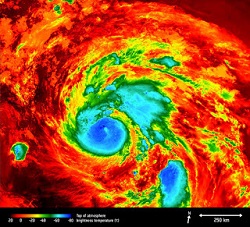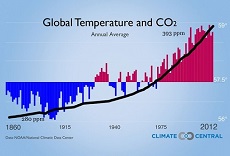This is the first of several posts which will show that climate change is becoming a real and present danger.
Climate Central has a graph showing the hottest 10 years on the record: Continue reading The heat is on!
This is the first of several posts which will show that climate change is becoming a real and present danger.
Climate Central has a graph showing the hottest 10 years on the record: Continue reading The heat is on!
Patrick Brown of Stanford University in California, working with Ken Caldeira, has found that the planet will warm 10 to 20 per cent more than previously thought. Here is the critical graph from their research:
James Hansen said in his book Storms for my Grandchildren that if we burnt all the available coal, tars, and oil then the ‘Venus Syndrome’ would be a dead certainty, extinguishing life as we know it on the planet. He has now thought further and says that is not going to happen, the time-scales make it impossible. It would take 100 million years to get enough carbon into the atmosphere, and by that time much of it would be back on the sea floor.
However we are on a path to make living at low latitudes impossible, plus more than half the major cities in the world cling to the coastline and are subject to sea level rise. The world, he says, would become ungovernable.
How likely is this? The short answer is that we appear to be on a path to achieve an ungovernable world within a century. Continue reading Climate change: the end of civilisation as we know it
Not well at all, according to the scientists. Actually it is a travesty of language to call Abbott’s position “science”. In this piece I’ll highlight the kind of thinking that unfortunately cannot be dismissed as an Abbott aberration, but has the Turnbull government in it’s thrall. Let’s start with David Rowe’s amazing cartoon from the AFR:
 Continue reading Abbott’s ‘Daring to doubt’ – how does the science stand up?
Continue reading Abbott’s ‘Daring to doubt’ – how does the science stand up?
On Monday and Tuesday this week we are going to have the AFR national Energy Summit in Sydney with everyone there, including Josh, Jay, Bill, Andrew Vesey and a different Malcolm Roberts (Chief Executive, APPEA). Should be fun.
The Weekend AFR had about half a dozen articles, led off by an article by Ben Potter, Angela Macdonald-Smith and Mark Ludlow (no doubt pay-walled) which said our energy has become dirty, expensive and annoyingly unreliable. They reckon something has to be done, it’s just that:
the causes identified by Prime Minister Malcolm Turnbull – or unofficial backbench energy spokesman Tony Abbott – are not the same as the causes power industry experts and regulators highlight. Continue reading Climate clippings 117
 For me the main point of George Monbiot’s article about Hurricane Harvey is that the course we are currently on to achieve 3.5 to 4°C of warming by the end of the century is equivalent in magnitude to the change between the last ice age and the balmy times of the Holocene. To talk about whether this or that extreme weather event was caused by anthropogenically induced climate change seems beside the point.
For me the main point of George Monbiot’s article about Hurricane Harvey is that the course we are currently on to achieve 3.5 to 4°C of warming by the end of the century is equivalent in magnitude to the change between the last ice age and the balmy times of the Holocene. To talk about whether this or that extreme weather event was caused by anthropogenically induced climate change seems beside the point.
The short answer is that everything about the climate has changed, so we are experiencing a climate that is different from how it would have been, and it will change much more during the life spans of the next few generations. Generally speaking, as Climate Central’s Climate Extremes Index indicates, extreme weather events are on the increase: Continue reading Storms for our grandchildren
Trump has picked a Republican politician, Rep. Jim Bridenstine of Oklahoma to oversee NASA, a job that often goes to astronauts or scientists.
Well, not everywhere, it’s dry here this winter, but definitely in Texas, and in India, Nepal, Bangladesh and now Pakistan. In fact, in the Indian subcontinent more than 1,400 people are dead since the recent rains started, and more than 45 million are directly affected, many having had their livelihoods destroyed. Mumbai, a city of some 20 million people, had a month’s rain in a single day. Two-thirds of Bangladesh was said to be under water. Here’s an early map from August 29:
We plant about 9 billion trees each year. Unfortunately we also clear about 15 billion, leaving a deficit of 6 billion.
A system of using drones is being developed which could plant trees at 10 times the rate of hand planting and at 20 per cent of the cost by firing germinated seeds into the ground. Continue reading Climate clippings 211
 Quiggin says, yes we can.
Quiggin says, yes we can.
I can’t comment on his blog, because the Askimet software has got me marked as a pest, and my comments go straight to spam. There is no facility for telling Askimet I’m OK, so there it is, I’m as good as banned. So I’ll make my comments here, which are in any case longer than is form for comments there.
I’d have to say I agree with Fran Bailey’s comment, the analysis seems entirely too optimistic. Continue reading Can we get to 350ppm?
In August last year in Climate clippings 181 (Item 5) I linked to a report by Climate Analytics examining the impacts on Australia of limiting global temperature rise to 1.5°C and 2°C.
For me the crux of the report is this, from a discussion piece at The Conversation:
If we go to 2℃, we will have a very different climate and there is a good chance we won’t be able to stabilise there. The bad news is that if we just carry on we’ll reach 1.5C by 2024, and 2C by 2036. Continue reading Science shows the need for urgent climate action